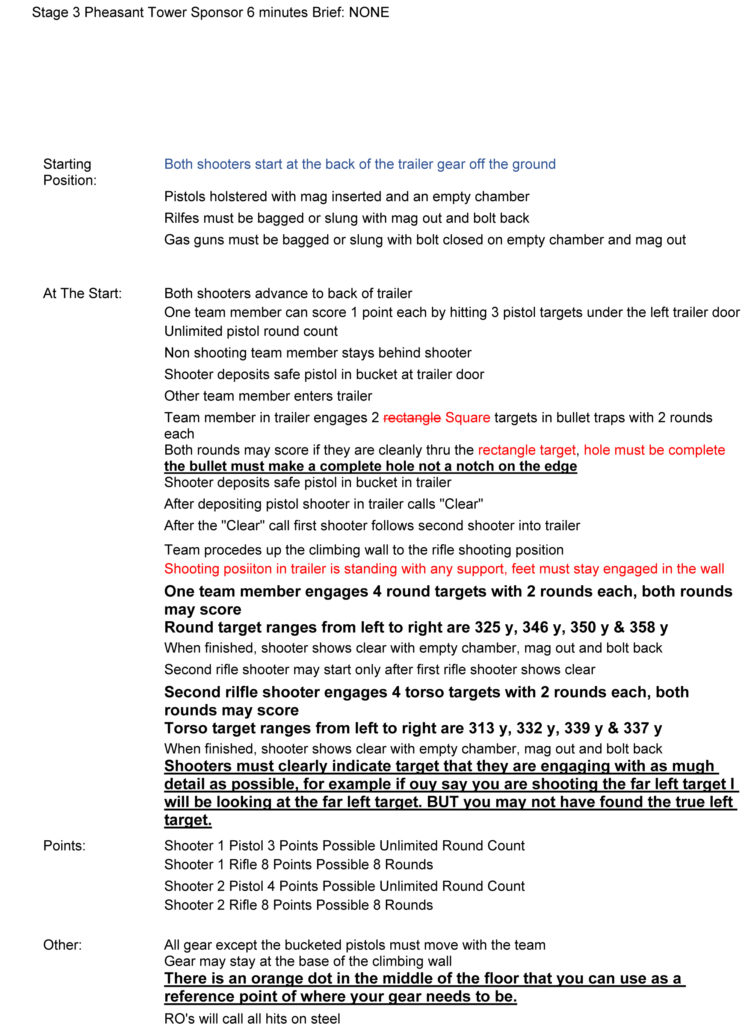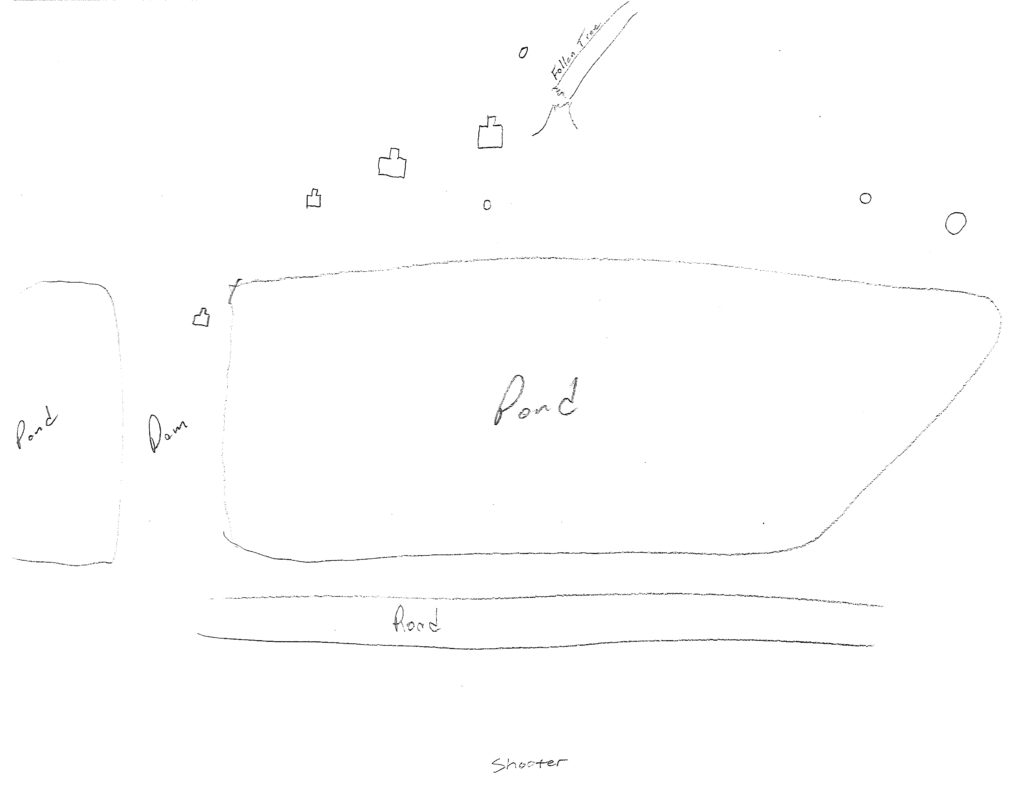“The benefits of giving your time to RO!”

In the 3 years that I have been shooting competitively I felt that I had learned a lot and my performance had progressed at a somewhat steady rate. During that time one of the things I found to be a wealth of knowledge were shooters AAR’s or After Action Reports, but one thing I have not really seen a lot of is an AAR of sort from those behind the glass and running the stages. Therefore that is what I have decided to do after the awesome chance to RO for the “Bushnell Elite Tactical Sniper Challenge at Clinton House Plantation” that my good friend and fellow shooter Joe Burdick was putting on with the assistance of Chris Andrews from Best Targets.
First a little background of how I ended up in what I feel is one of the best learning experiences I have had to date, and what ultimately led me to the decision to pen this article. A little over 2 years ago I decided that I wanted to shoot the Mammoth Sniper Challenge which is a team match that I heard about from day 1 of my endeavors in competition, so with Kahntrol Solutions sending product for the prize table we earned a free slot and the planning began for me and my brother Jeremy to shoot it together. However the morning we were supposed to leave I ended up in the ER with Diverticulitis and had to send Jeremy off with one of our other team shooters. Since then it was a goal to make it.
Fast forward to June of 2017 and I decided it was time to try again. I found a partner and once again with sponsor slot we were registered to shoot in the Toughman division (Had to make timed rucks between stages). Not long after that Joe announced the match at Clinton house, knowing I would be doing good to get ready for Mammoth there was no way that I would be able to recover in time (as well as already having to switch mammoth partners) for it I decided to finally step up and volunteer to RO for him. I say finally as I had not committed to a full match in the past, of course I had spent time on glass and helped brief and so forth, but this was the first time taking on full stages.
Now fast forward to Mid-December, with another partner change due to an injury it was now me and my brother Jeremy set to shoot open class at Mammoth. Of course both of us do good to get time on our rifles by ourselves so any practice together would have been a miracle. Sufficed to say we did not perform too well. Our communication was horrible, we barely knew what the other would do, and with me shooting a rifle with a new barrel and him shooting an unfamiliar rifle it was a set-up for disaster. While we were not last we weren’t to far up the ladder.
With the performance at Mammoth I actually became more enthusiastic about spending time watching 50 teams come through my stages to see what worked and didn’t work, both for teams and things that would translate over to individual shooting as well. I was not let down! I learned more in those 3 days than I could in a year of going out to the range and burning rounds and barrels, and all it cost me was some gas money. This brings us to this article in which I am going to do my best to pass on what I witnessed and what I feel were pluses and pitfalls in the way these teams did or did not perform.
Now allow me to give a little more detail about this particular match. Joe’s main focus was to give the opportunity for military and law enforcement teams to pit their skills against each other all while allowing civilians to see where they stack up again the “Professionals”. There were 50 teams registered of which 49 arrived (the last team had the flu). These teams consisted of military, national level law enforcement, state and local level law enforcement, and of course civilians from all walks of life.
Each team’s rifles had to consist of an open class rifle (rifles of any caliber choice and make up) with few restrictions that include 30 caliber or smaller and a 3150fps speed limit, the second rifle had to be either .308 winchester or 223/5.56. You saw a varying combination of AR’s and Bolt action rifles.
The teams were broken into 3 divisions:
- LRRP – Long Range Reconnaissance Patrol – this division was required to carry all gear for the entire match with them from the beginning of friday morning until the finish line Sunday afternoon. They rucked from stage to stage and back to a campsite each night where they slept. Each morning they had to completely break camp and load it all up. They were given 18 minutes per mile for the rucks and if they missed that time they were officailly out out of the competition in the position that they dropped the time hack at. From that point on they were essentially shooting for fun and practice and would ride along with the mechanized division (more on that in a moment).
- Trooper – This division did all of the above except no camping, and they only had to carry gear for the day. They still had to make the same time hacks on rucks with the same results for missing their goal.
- Mechanized – As you can guess this group rode instead of rucked. They still had to start the day with any gear they felt they might need as there was no going back to get more.
The best way I can think of to try and relay this info to you the reader is as follows:
- I will try my best to describe that scenario the shooters are placed into.
- I will paste in the exact verbiage of the stage brief I was handed to give to the shooters.
- In the brief I will put the areas that I verbally stressed in bold.
- Verbiage that I added will be bold and underlined, keep in mind that everything that I added or stressed, it was done for ALL squads.
- Since I am horrible about remembering to take pictures I have drawn up a range card as I would for the stage (had it not been blind).
- I will follow all of that with my interpretation of what the stage was meant to emphasize.
- And last but not least I will run down what I saw that worked, didn’t work, and how I would shoot it now that i have witnessed all of this.
Friday – The Pheasant Tower
This stage set-up consisted of a 52′ box trailer that when looking from behind it has the right door closed and the left door propped open to the side by a ladder leaning against so that it was sticking out to the side. As you looked under the left side door towards the front of the trailer there were 3 50% torso target ranging from about 10 yards to 25 yards. Under the open door to the trailer there was a wooden box to allow you to climb into it a LITTLE easier.
Once inside the trailer you see that most of the roof had been removed leaving only about 5 foot of roof at the front of the trailer and that you are immediately facing a wall of pheasant crates (this trailer is used to release pheasants for hunting and dog trials) that forced you to go to the right side of the trailer, when you reached the end you turned left to see another single stack of pheasant crates. Continue turning through this chicane and you can then see 2 indoor range bullet traps each with a 16″ x 16″ cardboard target.
Once you exit the stacks of crates and look towards the front of the trailer you see a climbing wall that goes up to the portion of roof that remains with a variety of holes and ledges for footholds.
Stage brief
Range Card
After helping set-up this stage and reading the brief to myself a couple of times Thursday night my take was that this stage focused on Making entry into a hostile environment, establishing an overwatch position, acquiring, identifying, communicated clearly the targets to the spotter (both the teammate and myself) for them to be able to observe and instruct whether the target was eliminated (target hit) or if it needed to be reengaged.
What I Learned
- It doesn’t matter how good your glass is, it pays to come off of it on occasion! One of the biggest pitfalls I witnessed were teams that once in the shooting position would go straight onto their rifle scopes and never lift their heads until they heard the shot timer signal the end of their time. The reason I say this is all throughout the day, with regularity to the point of I can say every team had the opportunity, the targets would have times of being shaded and when that happened they almost glowed and could be easily seen with the naked eye. This was reinforced by the multiple teams as the day progressed would either take the time to scan when they first got into position or come off their scope on occasion and I would suddenly hear them start counting targets as they lit up in the woods. They would then begin engaging the targets without spending more time hunting for them. Some of the later teams actaully had the larget opportunity to take advantage of the “glowing” targets as the sun set they were quite obvious to the naked eye.
- Follow instructions! I was amazed at how many teams got up there and started engaging any and all targets as they spotted them. You see the brief said the first shooter was to engage CIRCLE targets, a key point that apparently some did not deem important and then were surprised when they looked down and saw me looking up at them awaiting a target call rather than at the torso target they told me they were engaging (and on many occasions had just hit).
- Communication is key! As you noticed in the brief I would add and stress the sentence about clearly indicating which target they were engaging with the additional advice to give me clear indicators like what was around it and good landmarks to reference, this is for mulitple reasons, one is the fact that for the most part I could only watch one target at a time and I simply was not going to call hits on sound alone. The second reason I say this is something that I can honestly say only about 8-10 teams took advantage of (but is not in the range card). Within 2 feet of every target was an extra T-post that was unique in some way in it’s location left or right of target, primary color, and color of the top 10-12 inches. I don’t think this was intentional but it was one of the first things me and the other RO’s noticed while we were setting up and then orienting ourselves on the stage. Now the one caveat to the extra t-post was they were not quite as easy to see once the sun started setting, however see notes above referring to the “glowing targets”. Another huge landmark was the fallen tree, this thing was a HUGE 4-5 foot diameter tree that if you could not see it you seriously need to pay a visit to you local optometrist, or you needed to get off the glass. Several teams were able to give exact instructions to find their intended target based off of this tree. I was also surprised by how many would call out to me “far left torso” and then wonder why I did not call their hit which turned out to be on the third torso in from the left, well I was watching the “far left” target over on the dam. My favorite though was the one converstion that went something like this… Shooter “was that a hit?” Me “Negative, what are you shooting at?” (this is the exact response the match director told us to use) Shooter “The round target” Me “Which round target?” Shooter “The one across the pond” Me “They are all across the pond!” Shooter if you are reading this, nothing personal and I hope you can now see the humor in it that I did at the time.
- Not every target is going to be between 11 o’clock and 1 o’clock! This one got the best of a lot of teams in that they never looked over towards the right side of the pond to catch a glimpse of the large circle that was right out in the open with the smaller circle about 12 feet (10.3 mils for those still looking through their scope) to the left of it. And quite a few missed the 33% torso standing tall for all to see over on the dam, Yeah the “far left” target.
- Wind – What you feel is not always what you get! This is one that a lot of us know, yet we tend to forget when under stress. The lay of the land in this particular area made it such that the wind always felt like it was coming directly at you, despite the fact that there were full on right to left waves on the pond that some saw and some didn’t.
After all was said and done there were scores ranging from 0 to 15 spread pretty evenly across the board. I knew some left a little upset with me, but hopefully after talking to others that i made every effort to treat each shortly fairly and equally!
At this point I have to say this has turned into a little more article than planned, with that being said stay tuned for part 2 in the next couple of weeks. In that installment we will get into the “KD” stage also know as the Known Distance Stage with targets ranging from 100 to 1000 yards yet a simple 200 yard target directly in front of the shooters was one of the hardest targets to hit!


